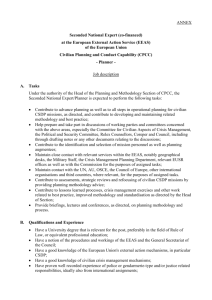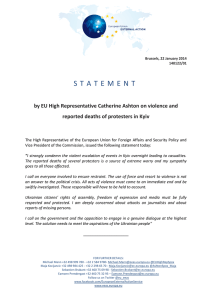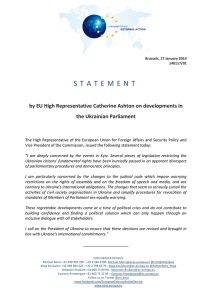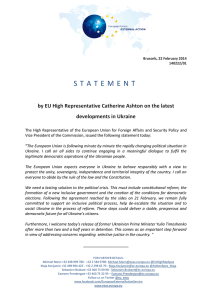Lectures & Seminars Series Lecture: Can the EU ever have a
advertisement
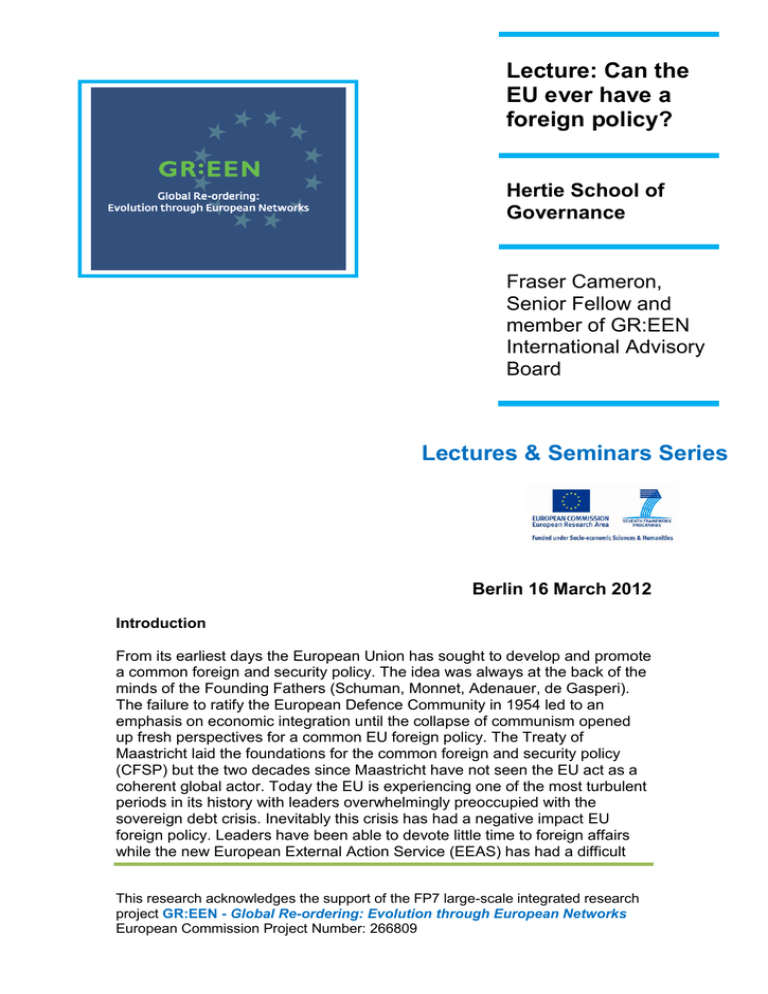
Lecture: Can the EU ever have a foreign policy? Hertie School of Governance Fraser Cameron, Senior Fellow and member of GR:EEN International Advisory Board Lectures & Seminars Series Berlin 16 March 2012 Introduction From its earliest days the European Union has sought to develop and promote a common foreign and security policy. The idea was always at the back of the minds of the Founding Fathers (Schuman, Monnet, Adenauer, de Gasperi). The failure to ratify the European Defence Community in 1954 led to an emphasis on economic integration until the collapse of communism opened up fresh perspectives for a common EU foreign policy. The Treaty of Maastricht laid the foundations for the common foreign and security policy (CFSP) but the two decades since Maastricht have not seen the EU act as a coherent global actor. Today the EU is experiencing one of the most turbulent periods in its history with leaders overwhelmingly preoccupied with the sovereign debt crisis. Inevitably this crisis has had a negative impact EU foreign policy. Leaders have been able to devote little time to foreign affairs while the new European External Action Service (EEAS) has had a difficult This research acknowledges the support of the FP7 large-scale integrated research project GR:EEN - Global Re-ordering: Evolution through European Networks European Commission Project Number: 266809 birth. The first double-hatted High Representative, Catherine Ashton, has come in for sustained criticism with many disappointed at the lack of progress following the Lisbon Treaty reforms. Meanwhile third countries have despaired of the EU‘s constant internal preoccupations. In these circumstances it is pertinent to pose the question – can the EU ever have a foreign policy? Background If there is one area where European elites and the public agree it is that there should be "more Europe" in foreign and security policy. Most Europeans seem to understand that in a rapidly changing international it is more urgent than ever that the EU speaks with one voice and acts together in external relations. Opinion polls throughout the member states have consistently shown over 70% in favour of a stronger and more CFSP. Yet governments seem incapable of harnessing this support to agree on reforms that would make genuine improvements to the CFSP established over twenty years ago at Maastricht. The CFSP had a difficult first decade starting with a baptism of fire in the Balkans. As Yugoslavia disintegrated into civil war, there were some who forecast that ‗the hour of Europe‘ had arrived. But far from the EU being regarded as the strong actor that could bang heads together and bring peace to the warring factions in Yugoslavia, it was regarded as weak and divided, both in the Balkans and in Washington. The whole Balkan experience and Kosovo in particular, was a tough learning experience for the EU. After the Amsterdam (1997) and Nice (2001) treaties, there were improvements to the CFSP machinery including a much-needed defence dimension. Javier Solana became the new, smiling face of European diplomacy and the EU gradually began to play a more assertive global and regional role learning to use its economic clout for political purposes, especially in the enlargement process. But to many observers the EU could do better if only its structures were improved. The Laeken Convention which led to the Lisbon Treaty called for a more coherent, consistent and visible foreign policy. Many thought this could only be achieved by an EU foreign minister – but foreign ministers traditionally represent states and the EU was not a state. So how to make progress? The Record Academics debate whether the CFSP cup is half empty or half full. A judgement depends very much on what expectations people have about the EU. For some member states, like the UK, a Eurosceptic public and concerns over national sovereignty ensures a limited role for CFSP. Belgium, in contrast, has always favoured a community approach to foreign policy with the European Commission playing a leading role. There are many shades of opinion in between. After the tough learning experience of the Balkans and the splits over Iraq in 2003 the EU gradually began to get its act together in foreign policy. It became the anchor for the Western Balkans promising membership to all states in the region in 2003. It enlarged from 15 to 25 countries in 2004 (and 27 in 2007). It began to play a more influential role in the Middle East and assumed a leadership role in climate change and efforts to establish the International Criminal Court (ICC). It established a 60,000 strong rapid reaction force (RRF) to be used for the so-called Petersberg tasks (i.e. humanitarian and rescue tasks, peacekeeping and crisis management). It had 2 to do this against the background of considerable suspicion by the US about whether these steps might undermine NATO. Some 20, mainly civilian, missions have been carried out. But there have also been tough missions with a strong military component in Bosnia, Macedonia and Kosovo. The Brussels Machinery The CFSP machinery created at Maastricht, which was based largely on the previous European Political Cooperation structures, has always been overly bureaucratic. The creation of a separate inter-governmental ‗pillar‘ for CFSP also led to numerous squabbles over issues of competence. Another problem was the sheer number of actors involved in CFSP; the Member States, the Council (Coreper, PSC and the 35 Plus working groups), the High Representative, the Special Representatives, the Commission, the Parliament, each with their bureaucracies, interests and ambitions. After Amsterdam, the Council‘s role increased with Javier Solana becoming an increasingly visible figure of European diplomacy. The Treaty was deliberately vague on his responsibilities as High Representative, stating that he ―shall assist the Presidency". Inevitably in such a situation much depends on the personality of the office-holder and the EU was fortunate in having someone of Solana's stature as the first ‗Mr CFSP.‘ As a former Spanish foreign minister and ex-NATO secretary general he came to the EU job with considerable experience and a multitude of contacts. Yet Solana operated with woefully inadequate resources, in terms of staff and money. It was the Commission that had the manpower and finance; and a network of 135 delegations around the world. The situation was further confused by the six-monthly rotating Presidency, often setting its own (national) priorities. A plethora of different legal bases for external action in the CFSP, development, trade and monetary fields further complicated the picture. The Lisbon Treaty, Ashton and the EEAS There were high hopes on all sides that the new institutional mechanisms under the Lisbon treaty, especially the creation of a double-hatted High Representative supported by a new EU external action service (EEAS), would lead to the long sought after holy grail of a more coherent, consistent and visible foreign policy. The treaty did not give the HR (Catherine Ashton) any substantial new powers. She could chair the foreign affairs council and present policy initiatives but she could not speak on behalf of the EU unless all 27 member states were agreed. The added value of the post was that as Vice President of the Commission she could coordinate the work of the other Commissioners dealing with external affairs and thus present a more consistent and coherent approach to the outside world. Regrettably, Ashton has neglected to use her Commission hat. She rarely attends meetings of the Commission nor has she made much effort to coordinate other Commission services as was envisaged. Instead the individual Commissioners dealing with trade, development, enlargement, etc have gone their own way, keeping their substantial financial and human resources. It is rumoured that President Barroso is not unhappy with this state 3 of affairs. Indeed there are many who consider that the new structure is actually less coherent than the previous structures. It is worth recalling that back in 2003 during the constitutional convention Solana and Patten both argued against the double-hatting experiment. Despite flaws in the old system it was obvious that anyone trying to combine two (or three) jobs would face an impossible task. Furthermore, establishing the EEAS as a sui generis institution immediately created walls between it and other parts of the Brussels bureaucracy, especially the Commission. During her first year in office Catherine Ashton devoted most of her time to establishing the EEAS. In typical Brussels fashion there were constant turf wars between the institutions each wanting to protect its interests. Ashton‘s appointment had been the subject of some controversy as there were clearly candidates with greater foreign policy experience. But the intricacies of top EU appointments ensured that the post would go to a socialist and a female which limited the choice. According to Lisbon the EEAS was to ‗work in cooperation with the diplomatic services of the member states and comprise officials from the Council, Commission as well as staff seconded from national diplomatic services.‘ It was to be a functionally autonomous body, separate from the Commission and Council under the authority of the High Representative. It was to support her in fulfilling her mandate and also ‗assist the President of the Commission and the President of the European Council as well as extending appropriate support to the other institutions and bodies of the Union, in particular the European Parliament.‘ The EEAS was ‗to cooperate with the Council and the Commission as well as with the diplomatic services of the member states in order to ensure consistency between the different areas of the Union external action and between these nd its other policies. It shall in particular coordinate with the Commission departments. In this vein the EEAS and the Commission services in question shall consult each other on all matters relating to the external action of the Union, and the EEAS and the Commission shall take part in their respective preparatory work.‘ Criticism of the EEAS The criticism of Ashton and the EEAS has been relentless. In December 2011 a group of EU foreign ministers wrote to her urging the need to identify priorities and better prepare the monthly foreign affairs councils. The ministers said that the EEAS should produce more policy papers and circulate them early enough to be useful for the meetings. In a report on the first year of operation of the EEAS which she submitted at the end of 2011 Ashton acknowledged problems in the division of roles between the EEAS and the European Commission. She conceded that there were serious transitional and structural problems with the EU's 140 delegations abroad. She noted the need to improve policy formulation and delivery, but provided no details as to how she would do so. 4 Both Ashton's report and the ministers' paper were critical of the Commission for being unhelpful and even hostile to the EEAS. The Commission routinely issues direct instructions to Commission staff working in EU delegations instead of routing them through the head of delegation. Many delegations are predominantly staffed by Commission officials; more than 20 delegations have no senior EEAS officials other than the ambassador. Ashton's report said that there was ―considerable concern‖ that ambassadors cannot delegate their financial responsibilities because current rules prevent Commission officials from dealing with the service's administrative funding. As a result, an ―excessive burden of routine administrative management‖ falls on the heads of delegation, whose main role should be political. The ministers backed Ashton's proposal for delegations to have defence and security attachés. But the foreign ministers also made it clear that it was Ashton's responsibility to manage relations between the EEAS and the Commission. ―Close cooperation between the EEAS and the Commission is essential for effective and coherent EU external action,‖ they wrote. ―As vice-president of the Commission, the high representative [Ashton] plays a key role in co-ordinating the external relations aspects within the Commission.‖ One of the strongest critics was Toby Vogel, editor of the European Voice. In a hard-hitting editorial on 5.1.12 he wrote that ‗a year ago, some people inside and outside the EEAS harboured hopes that Ashton, who had practically no foreign policy experience, would grow into her role. Those hopes have withered; her leadership is as erratic, and her authority as lacking, as it was a year ago. Officials and diplomats from inside and outside the EU have accepted that her flaws will hamper the EU's foreign policy for as long as she is in office. Ashton's biggest flaw, Vogel continued, bigger than her lack of diplomatic experience, was an inability to trust people and let them get on with their jobs. She micromanages processes that she should delegate, while entire policy areas – notably defence and security – are left on autopilot because of her lack of interest. The EEAS has failed to provide intellectual leadership. The only people who appear happy with Ashton are the Americans because she gets the EEAS to deliver on issues that are important to American interests, such as Iran. Ashton is not solely or wholly responsibly for all of these problems but among all the design flaws that have held back the EEAS, by far the biggest has been to put Ashton in charge of it. One of the more moderate critics of the EEAS is Stefan Lehne, a former senior official during the Solana era. He has suggested that ‗roughly one year after its establishment, the EEAS still suffers from a number of design flaws. It has an insufficient resource base and there is a lack of genuine buy-in on the parts of both the member states and the European Commission.‘ In some ways, he concludes, the situation is worse today than it was under the previous system of fragmented roles. Lehne suggests that these flaws could be overcome if corrective action is taken: 5 Enhance the buy-in of member states: For the EEAS to grow into a dynamic leader of European foreign policy, member states must trust it more and support it more actively. In order to achieve this, the high representative should promote the systematic involvement of the member states‘ diplomacies in the work of the EEAS, through increased tasking of foreign ministers with European missions, delegation-embassy teamwork, information sharing, and a supporting role for the EU delegations in the area of consular protection. Strengthen the coherence of external action: Expectations that the Lisbon Treaty would narrow the gap between classical diplomacy and the external competencies of the European Commission in areas such as trade, development, energy, and the environment have not materialized. Both the Commission and the high representative need to take action in order to ensure that the various instruments of external policy can become part of a comprehensive and coherent strategy. Set clear priorities: The EEAS has a lot on its plate, and without strong leadership and direction, much of its activity turns into empty words and sterile rituals. The high representative must take a stronger lead in setting priorities, in giving strategic direction, in streamlining the political dialogue with international partners, and in building a record of concrete policy successes through well-targeted personal engagement. Improve institutional capacity: Today, there are probably fewer officials working on European foreign policy than before the Lisbon Treaty. The EEAS needs more manpower, better integration of its diverse components, and improved recruitment and training practices. The chain of command and the procedures should be reviewed to allow the EEAS to respond more rapidly to developments. Lehne's paper rightly says the EEAS should focus on a small number of priorities, and seek some early achievements. Nothing breeds success like success itself. But this is not so easy, for at least two reasons. First, with 27 member states it is hard to have a small list of priorities. Newer members in eastern Europe want to focus on the Eastern Partnership. Southern Europeans want focus on North Africa. Big powers want a role in the ArabIsraeli conflict, Iraq and Iran. And if the EEAS cannot act in the Balkans, what is the point of having it? The EU institutions obviously want their new diplomatic service to deal with ―strategic partners‖: America, Russia, China, 6 India and Brazil. As one of the world's biggest aid donors, the EU can hardly stand aloof from Africa. Many member-states have colonial bonds in Latin America, the Caribbean and other far-flung places. As you see, the list of priorities expands quickly. The EU can probably afford to ignore Papua New Guinea and Micronesia, but someone, somewhere, will find reasons why they are important too. The second problem is that you cannot have success simply by willing it. Particularly in foreign policy, you can control the inputs—the number of meetings, the amount of aid, etc, but the outcomes are unpredictable as we have seen most recently in Egypt, Libya and Syria. The Arab spring was the great opportunity for European foreign policy. In fact the neighbourhood policy produced by Catherine Ashton and the Commission was sensible, offering post-dictatorial Arab states the Three Ms: mobility, markets and money. But we discover that these are not in the gift of the EEAS. They can be granted by the Commission, to some extent, and above all by member-states. In recent weeks the reports and assessments on the EEAS have been coming in thick and fast. One poor grade comes from the foreign-policy ―scorecard‖ issued by the European Council on Foreign Relations. Another think-tank, FRIDE, analyses more generally the growing trend towards commercial interests in "Challenges for European Foreign Policy in 2012." The EPC, Egmont and Notre Europe were among other think tanks that offered critical views (see bibliography). The Economist EU correspondent was equally blunt in his blog opining that a year after the launch of the EEAS fewer and fewer people have anything good to say about its boss, Cathy Ashton. ‗The despair is palpable. The EEAS is simply irrelevant. I have stopped reading the endless statements that the service puts out. It is trying to take the lead from foreign ministers who already feel they are being marginalised—by prime ministers who conduct their own foreign policy, and by a Brussels system that now regards finance ministers as the princes. - The EEAS is trying to establish itself in a time when Europe's soft power is crumbling fast. The crisis over the euro affects everything. It seems to me you can have an inexperienced foreign minister with an established bureaucracy, or an experienced foreign minister with no bureaucracy. You can't have an inexperienced foreign minister with no foreign ministry.’ Brussels Bureaucracy The machinery of EU foreign policy is extremely complex with no single telephone number. One of the most sensitive issues is money. In January 2012 details of a new inter-service agreement on who does what in managing the EU‘s €9.5-billion-a-year external relations budget between the EEAS and Commission was leaked to the press. It said the Commission and the EEAS "jointly" plan overall spending strategies on the Union's priorities. But development commissioner Andris Piebalgs, neighbourhood commissioner Stefan Fuele and aid commissioner Kristalina Georgieva keep full control of designing and implementing actual projects in the 104 countries and €7.5 billion covered by their portfolios. "The EEAS shall refrain from taking any 7 measures ... on issues which fall under Commission competence," the agreement stated. The Commission also has part-control of three crisis management and pro-democracy funds - the so-called EIDHR, IfS and CFSP, worth €1 billion. Ashton proposes EIDHR and IfS projects, but then Piebalgs' people take over and draft the final blueprints, while keeping EEAS staff "informed" and inviting them to meetings. Ashton also proposes CFSP projects, but a Commission office - the Service for Foreign Policy Instruments [FPI] - writes the assessment study used by EU countries to decide which ones go forward and writes the final blueprint. On top of this, Commission officials oversee how Ashton spends her €500-million-a-year internal budget. The service pact says her ambassadors "will be tasked with timely, accurate and reliable reporting to the relevant Commission AOD [Authorising Officer by Delegation], according to intervals and format decided on by the Commission." The Commission even has power over Ashton's media relations. The FPI handles the EEAS press and communications budget. The Commission decides if she gets a spot on its internet TV - the European Broadcasting Service - and its spokespeople must be told "in a timely manner" if she wants to do a press release. Meanwhile, EU ambassadors spend much of their time taking instructions from and preparing reports for Piebalgs, Fuele and Georgieva's departments, as well as doing the paperwork on the three commissioners' projects in their role as "sub-delegated" accounting officers. In one example, if the EEAS wants to release up to €20 million in emergency funds the decision must go through Ashton's secretary general, her private office, the FPI, ‗relevant commission services‘ and the Political and Security Committee (a group of EU countries' ambassadors). As one DG Devco official told the author ‗Ashton can make as many statements as she wants – but we control the money.‘ Conclusion Many consider that Catherine Ashton has an unenviable, even impossible job, trying to do what three ministers did in the past. Others blame her for the trials and tribulations of EU foreign policy. There will be a review of the operation of the EEAS in 2013 which will allow member states to decide if changes are required. But EU foreign policy must be viewed within the framework of EU integration as a whole. The outcome of the sovereign debt crisis and the successful conclusion of the proposed fiscal compact could well have an impact on external relations At the end of the day CFSP depends on the political will of its Member States and there are inevitable limitations in the conduct of foreign policy in a Union that wishes to retain the independence and identity of its member states. In some important areas the EU finds itself ham-strung but these areas are becoming fewer as the Member States come to accept the advantages of working together. The national obsessions of some Member States may indeed have beneficial effects for the EU. The Union would never have paid so much attention to East Timor, for example, without the forceful prodding of Portugal over the years. The task of the institutions is to make it easier for the Member States to integrate their efforts and then to promote common policies more effectively. It was always unlikely, given the sensitivities of Member States, that one should have expected significant changes as a result of the Lisbon treaty. (It is worth 8 reflecting how many member states broke the rules of the growth and stability pact with impunity). Despite occasional criticism, most Member States appear comfortable with present arrangements which allow them to continue with their own national foreign policies and supporting the EU position as and when they like. The CFSP approaches puberty after a difficult childhood with little sign that its parents have overly high ambitions for its future. As Chris Patten once remarked "if the CFSP is to grow to maturity, it needs the nurture of both its parents, the Member States and the Community institutions. And as any psychologist will tell you - the child is more likely to be happy and healthy if those parents love one another". There is not much sign of love in the EU just now. Short Bibliography Fraser Cameron, An Introduction to European Foreign Policy, 2nd edition, Routledge, 2012 Stefan Lehne‘s paper More Action, Better Service: How to Strengthen the European External Action Service is available on the website of Carnegie Europe. Sami Adoura‘s article Europe abroad: 20 years after Maastricht, Is there anybody there?’ is available on the website of Notre Europe. The scorecard on EU foreign policy can be accessed via the website of the European Council on Foreign Relations. The EPC publication The European External Action Service at work - How to improve EU foreign policy can be found on its website. Sven Biscop, Rosa Balfour & Michael Emerson (Eds.) have issued an Egmont paper on The Arab Spring – a springboard for EU foreign policy? available on the Egmont and CEPS websites. 9
